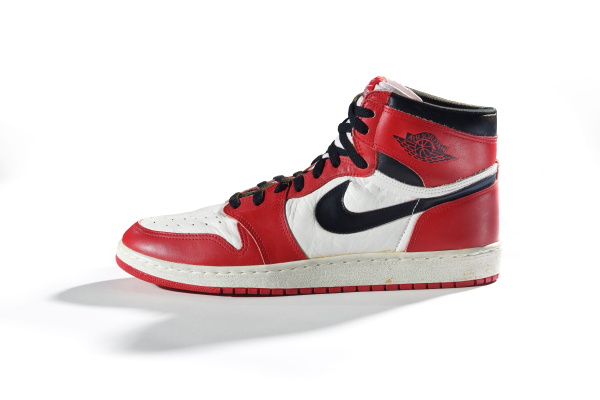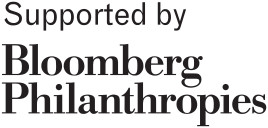
Nike. Air Jordan I, 1985. Nike Archives. (Photo: Ron Wood. Courtesy American Federation of Arts/Bata Shoe Museum)

Nike. Air Jordan I, 1985. Nike Archives. (Photo: Ron Wood. Courtesy American Federation of Arts/Bata Shoe Museum)

Thomas Dutton and Thorowgood. Running Shoe, 1860–65. Northampton Museums and Art Gallery, Northampton, UK. (Photo: Greg Washington. Courtesy American Federation of Arts/Bata Shoe Museum)
A new fashion for “pedestrianism,” or competitive walking, emerged in the early 1800s, and by the middle of the century, competitive running had also grown in popularity, with most of its serious participants still wearing leather shoes.
This pair, thought to be the oldest extant example, resembles men’s dress shoes of the period with the exception of the spikes on the soles, which give away their true purpose. The broad band of leather across the instep, added for support, also indicates their use in sport.

Converse Rubber Shoe Company. All Star/Non Skid, 1917. Converse Archives. (Photo: Courtesy American Federation of Arts)
The Converse Rubber Shoe Company debuted its new indoor gym shoe, the All Star, in 1917. Brown canvas models were marketed as All Stars, while the same shoes in white canvas and with a slightly different tread were called Non Skids. Both featured the brand’s signature toe cap, toe bumper, license plate on the heel, and a patch over the inner ankle for protection. Basketball coach Chuck Taylor joined the company in the early 1920s, both to promote the sneaker and to advise on its design and development; his name was added to the All Star in 1934.

Gebrüder Dassler Schuhfabrik. Modell Waitzer, 1936. adidas AG. (Photo: adidas AG / studio waldeck. Courtesy American Federation of Arts)
Adolf Hitler viewed the 1936 Berlin Olympics as an opportunity to flaunt his assertion of Aryan racial superiority through the athletic prowess of the German athletes. The astonishing performance of African American athlete Jesse Owens refuted these views, with Owens winning four gold medals, the most awarded to any Olympian to that date.
German shoemaker and future Adidas founder Adi Dassler boldly offered his athletic shoes to Owens, who tested them while in Germany for the Olympics. Owens wore a bespoke pair of Modell Waitzers at Olympic practices.

adidas x Run–DMC. 25th Anniversary Superstar, 2011. Courtesy of Run–DMC, collection of Erik Blam. (Photo: Ron Wood. Courtesy American Federation of Arts/Bata Shoe Museum)
In 1986 Run–DMC invited Adidas executives to Madison Square Garden to hear them perform their hit single “My Adidas.” Adidas responded by giving the rappers a million-dollar contract, making them the first non-athletes to receive a sneaker deal.
Run–DMC wore Superstars without laces, a controversial choice as the fashion originated in prisons, where laces were removed as a safety precaution. This autographed pair of Superstars was released November 11, 2011, in honor of the rap single’s twenty-fifth anniversary.

Nike. Waffle Trainer, 1974. Northampton Museums and Art Gallery, Northampton, UK. (Photo: Ron Wood. Courtesy American Federation of Arts/Bata Shoe Museum)
In his quest to make lightweight running shoes, Bill Bowerman was constantly seeking improvements. In 1965, he collaborated with Blue Ribbon Sports’ first employee, Jeff Johnson, to introduce nylon uppers and cushioned insoles, but it was not until he destroyed his wife’s waffle iron that he revolutionized the running shoe. Bowerman discovered that by pressing rubber into this appliance, he could create soles that used less material, yet featured durable treads. His famously lightweight Waffle Trainer debuted in 1974.

adidas. Micropacer, 1984. Collection of the Bata Shoe Museum, Toronto; Gift of Phillip Nutt. (Photo: Ron Wood. Courtesy American Federation of Arts/Bata Shoe Museum)
The revolutionary 1984 Adidas Micropacer had a microsensor in the left toe that could record distance, running pace, and caloric consumption. This information was retrieved on the readout screen found on the tongue of the left shoe. The small screen was only one of the sneaker’s futuristic aspects; the silver-gilt leather and unusual lace covers also heralded a new era of technology-enhanced athletic performance.

Nike x Tom Sachs. NikeCraft Lunar Underboot Aeroply Experimentation Research Boot Prototype, 2008–12. Collection of the artist. (Photo: Courtesy American Federation of Arts)
American artist Tom Sachs creates works that engage issues surrounding the fetishization of branding. He is a proponent of the concept of bricolage, or makeshift handiwork constructed out of materials at hand. Responding to the perfected anonymity of mass-produced consumer goods, he strives to retain the mark of the maker in his work. With these principles at the forefront of his work, his collaboration with Nike, called NikeCraft, offered unique challenges, but Sachs’s hand is evident in the footwear he created for the project.
The moon boot was a prototype. The manufactured sneakers, which retain a handcrafted feeling, are made with Nike Special Forces outsoles and Vectran fabric from the airbags on the Mars Excursion Rover. Rather than designing such footwear with athletes in mind, Sachs stated that “these shoes are built to support the bodies of the strongest minds in the aerospace industry.”

PUMA x Undefeated. Clyde Gametime Gold, 2012. PUMA Archives. (Photo: Ron
Wood. Courtesy American Federation of Arts/Bata Shoe Museum)
The Clyde Gametime Gold shoe, with perforations on the uppers and red, white, and blue heel tabs, was created in homage to the U.S. gold-medal-winning Olympic basketball team. Puma first collaborated with Undefeated, an urban fashion brand and boutique founded in Los Angeles, in 2009, and again in 2011 and 2012.

Pierre Hardy. Poworama, 2011. Collection of the Bata Shoe Museum, Toronto; Gift of Pierre Hardy. (Photo: Ron Wood. Courtesy American Federation of Arts/Bata Shoe Museum)
Fashion designer Pierre Hardy launched his line of footwear for women in 1999 and for men in 2002. Among his many designs are sneakers that play with primary colors and geometric shapes. The design of this pair of limited-edition Poworamas was inspired by the Pop art style of Roy Lichtenstein.
The Rise of Sneaker Culture
July 10–October 4, 2015
From their modest origins in the mid-nineteenth century to high-end sneakers created in the past decade, sneakers have become a global obsession. The Rise of Sneaker Culture is the first exhibition to explore the complex social history and cultural significance of the footwear now worn by billions of people throughout the world.
The exhibition, which includes approximately 150 pairs of sneakers, looks at the evolution of the sneaker from its beginnings to its current role as status symbol and urban icon. Included are works from the archives of manufacturers such as Adidas, Converse, Nike, Puma, and Reebok as well as private collectors such as hip-hop legend Darryl “DMC” McDaniels, sneaker guru Bobbito Garcia, and Dee Wells of Obsessive Sneaker Disorder. Also featured are sneakers by Prada and other major fashion design houses and designers, as well as those made in collaboration with artists including Damien Hirst and Shantell Martin. Film footage, interactive media, photographic images, and design drawings contextualize the sneakers and explore the social history, technical innovations, fashion trends, and marketing campaigns that have shaped sneaker culture over the past two centuries.
The Rise of Sneaker Culture is organized by the American Federation of Arts and the Bata Shoe Museum, Toronto. It is curated by Elizabeth Semmelhack, Senior Curator, Bata Shoe Museum.
The Brooklyn presentation is organized by Lisa Small, Curator of Exhibitions, Brooklyn Museum.
A fully illustrated catalogue, co-published by the AFA in partnership with the Bata Shoe Museum and Rizzoli, accompanies the exhibition.
Generous support for the national tour of the exhibition is provided by Macy’s.





